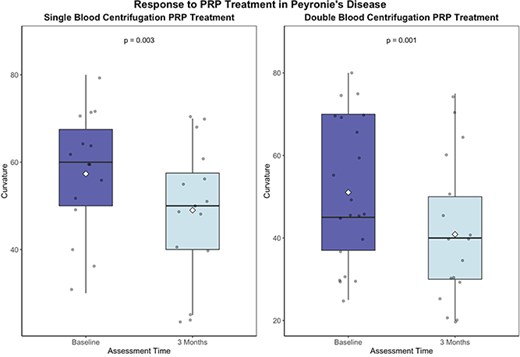-
PDF
- Split View
-
Views
-
Cite
Cite
F Negri, L Zahiti, G Birolini, E Pozzi, A Bertini, C Corsini, M Raffo, L Boeri, A d'Arma, F Montorsi, A Mattei, A Salonia, INTRA-PLAQUE PLATELET-RICH PLASMA (PRP) INJECTIONS FOR STABLE PHASE PEYRONIE’S DISEASE: A TWO-CENTER REAL-LIFE PROSPECTIVE PILOT STUDY, The Journal of Sexual Medicine, Volume 22, Issue Supplement_2, May 2025, qdaf077.093, https://doi.org/10.1093/jsxmed/qdaf077.093
Close - Share Icon Share
Abstract
Platelet-Rich Plasma (PRP) injections have emerged as promising approach for treating stable-phase Peyronie’s Disease (PD), although it is still investigational. We aimed to analyze the preliminary results of 2-center real-life prospective pilot study.
Data from 38 patients undergoing two intra-plaque PRP injections were prospectively collected. Patients underwent dynamic penile Color Doppler-duplex ultrasound (CDDU) at baseline. Patients completed International Index of Erectile Function (IIEF-EF) and Peyronie’s Disease Questionnaire (PDQ) at baseline and follow-up. According to the center, PRP was obtained using a double or single blood centrifugation. All patients received two injections, each consisting of an average of 4 + 4 mL of PRP, administered 4 weeks apart. Patients had a 3-mo follow-up assessment, including repeated CDDU, IIEF-EF, and PDQ. Descriptive statistics were used to detail population characteristics and changes in terms of curvature, IIEF-EF, and PDQ scores 3-mo after.
Median (IQR) age was 60 (54-67). 22 (57.9%) received PRP injection after 2 centrifuge cycles and 16 (42.1%) after 1. The 2-cycle group showed a median penile curvature of 45° (37-70) at baseline, which decreased to 40° (30-50) at 3-mo follow-up (p = 0.001). The 1-cycle group had a baseline median curvature of 60° (50-67.5), which decreased to 50° (40-57.5) (p = 0.003), Fig. 1. Overall, the median (IQR) penile curvature was 55° (45-70) at baseline and significantly decreased to 45° (30-55) after PRP treatments, with a median reduction of 10° (p = 0.02). The median (IQR) IIEF-EF and PDQ scores were 21.5 (12.3-26.8) and 22.0 (18.0-34.0), respectively, at baseline, while 23 (13.8-26) and 18 (14.5-22) at 3-month, showing no significant difference from baseline. The median (IQR) peak systolic velocity showed non-significant increase from 38.8 cm/s (35.2-53.8) to 46.9 cm/s (37.9-64.5) at 3-mo follow-up (p = 0.11). Median plaque diameter decreased from 14.0 to 9.6 mm post-treatment. No adverse effects were reported.
Preliminary findings indicate that PRP injections are safe therapeutic option for stable phase PD. We observed a median 10° improvement in penile curvature at 3-mo follow-up, with both one and two centrifuge cycles showing significant curvature reduction. The observed decrease is inadequate to extrapolate reliable significant long-term outcomes.
None.




